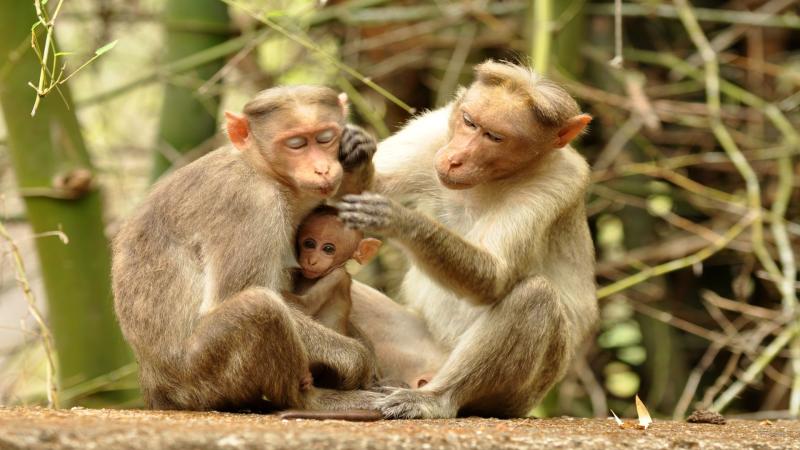
“We admit that we are like apes, but we seldom realise that we are apes,” said Richard Dawkins, an English evolutionary biologist. We often don’t realise that we share more similarities with our primate cousins than the differences. Communication is one such trait. Although humans have evolved a complex system of communication as expressed through language, primates are perhaps not far behind. Basic signals like facial expressions, gestures and vocalisations, used to share information, are used by humans and other primates. In a new study, researchers from the National Institute of Advanced Studies, Bengaluru, have investigated and compared gestural communication in wild bonnet macaques (Macaca radiata), to those in other apes.
A gesture, as per previous studies conducted on ape communication, is a discrete, mechanically ineffective movement of body parts to elicit a behavioural response from the recipient. This definition is originally derived from the field of human psychology, and the same has been applied in the present paper to define monkey gestures.
“Since our goal is to understand and compare linguistic features in non-ape primates, it is critical to use the same definitional criteria,” reasons Dr Shreejata Gupta. She is currently a researcher at the University of York and is the lead author of the study.
Bonnet macaques are a species of monkeys endemic to peninsular India and are evolutionarily older than apes. They are remarkably adaptable to different habitats and are a behaviourally flexible species. They are found in a variety of habitats, ranging from tropical rainforests to dry deciduous forests and coastal habitats to human habitations. The researchers studied gestural communication of these primates in the Bandipur National Park of Karnataka for their study. The study, published in the journal Behavioural Processes, was funded by the Department of Science and Technology, Government of India. The findings show that vital cognitive features, found in human languages, are also prevalent in the communication systems of wild bonnet macaques.
The researchers found that these macaques intentionally use 32 defined types of gestures to communicate with each other and achieve a social goal. The researchers have classified the observed gestures into functional repertoires, depending on the contexts in which they are used.
“A repertoire is a list of behaviours belonging to the same or similar category of behaviours”, explains Dr Gupta. They are grouped as either affiliative, agonistic or play repertoires, which are the most frequently observed behaviours in these macaques.
For example, allogrooming, or social grooming, is classified as an affiliative behaviour. Here, one animal sifts through the fur of another, removing ectoparasites or pieces of dry skin. Sometimes, these parasites may even be consumed by the groomer! On the other hand, intra-group fighting is termed agonistic.
“Play behaviour is difficult to define. You know it is play when you see it. Usually, infants and juveniles engage in this kind of behaviour,” explains Dr Gupta.
The researchers speculate that the macaques could also use gestures during other activities like travelling, foraging and mother-infant interactions.
The researchers argue that these gestures are intentional as the signalling macaques persistently repeated the same gesture if the receiving partner failed to notice it and respond. Interestingly, a previous study from Prof Sinha and Dr Gupta found that these macaques from Bandipur display certain novel gestures in response to human activities too. As the Bandipur National Park is a tourist attraction, the macaques are known to extend their hand, requesting food from tourists. The researchers here have now documented that wild macaques can learn such manual gestures and use them intentionally. The study is the first-ever effort to provide a fundamental understanding of the complex gestural communication in a non-ape primate species.
“So far, we knew chimpanzees, bonobos, gorillas and orangutans have language-like capacities underlying their communication systems. Our findings make a fundamental contribution by establishing these same capacities in the communication systems of a wild monkey species,” says Dr Gupta.
Similar studies could pave the way for understanding the evolution of human language and help us realise how closely connected we are to our primate cousins.
“The take-home message from our findings is straightforward. We should always remember that the human species is a product of millions of years of evolution, similar to all other life forms around us. Therefore, to a lesser or greater extent, we are connected to all flora and fauna that exist. Be it similarities in our mental and communicative capacities, or our morphology, physiology and sociology, this shared natural history should never fail to induce empathy within ourselves when we interact with nature and other lifeforms,” signs off Dr Gupta.
This article has been run past the researchers, whose work is covered, to ensure accuracy.
























